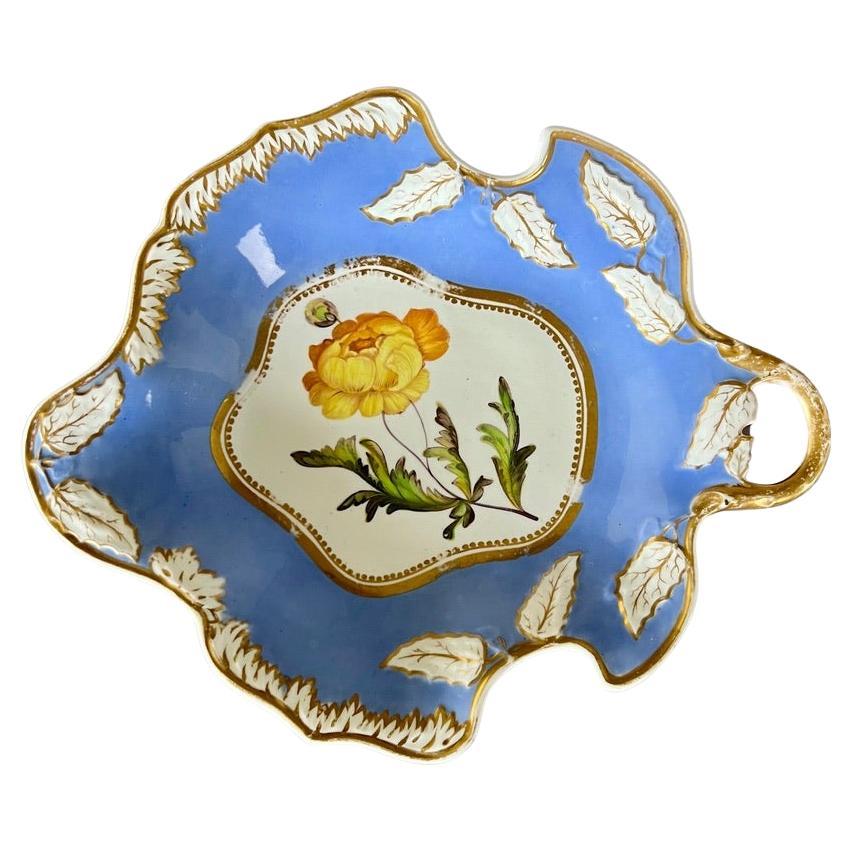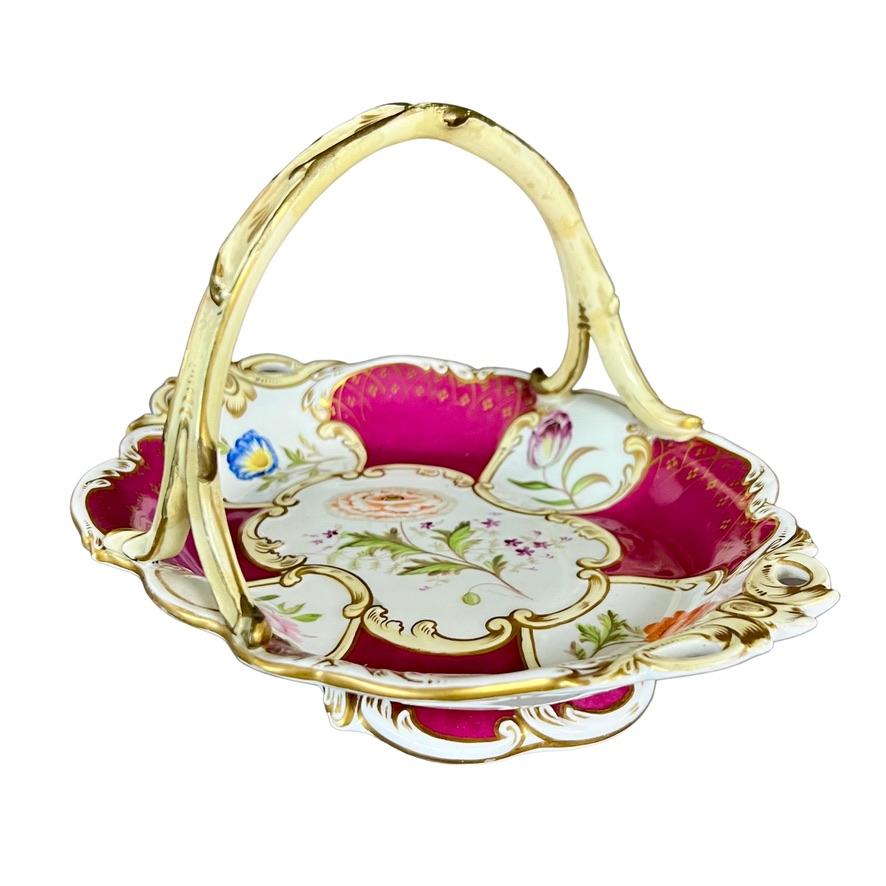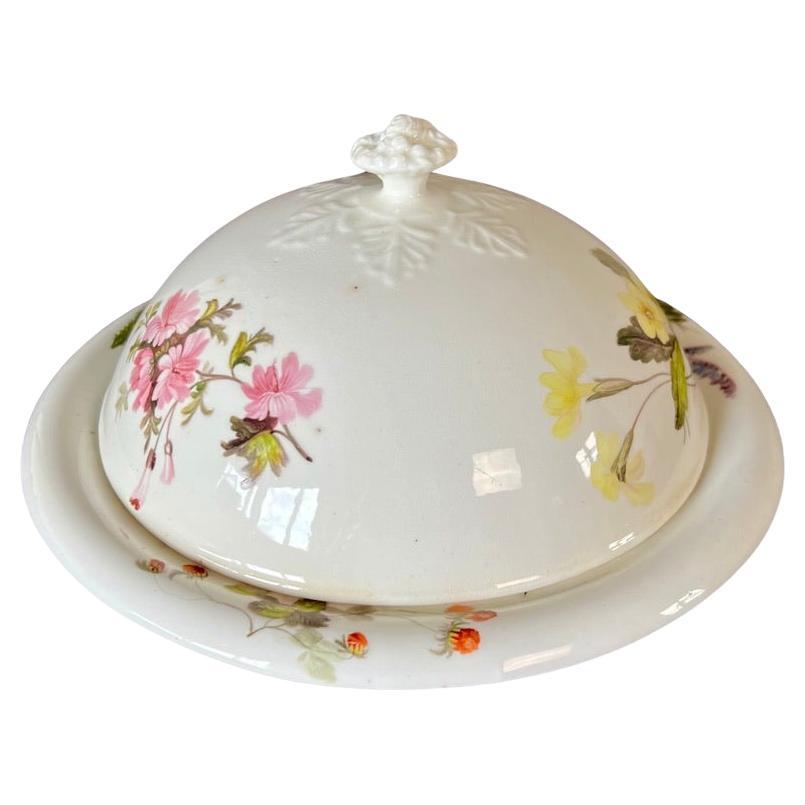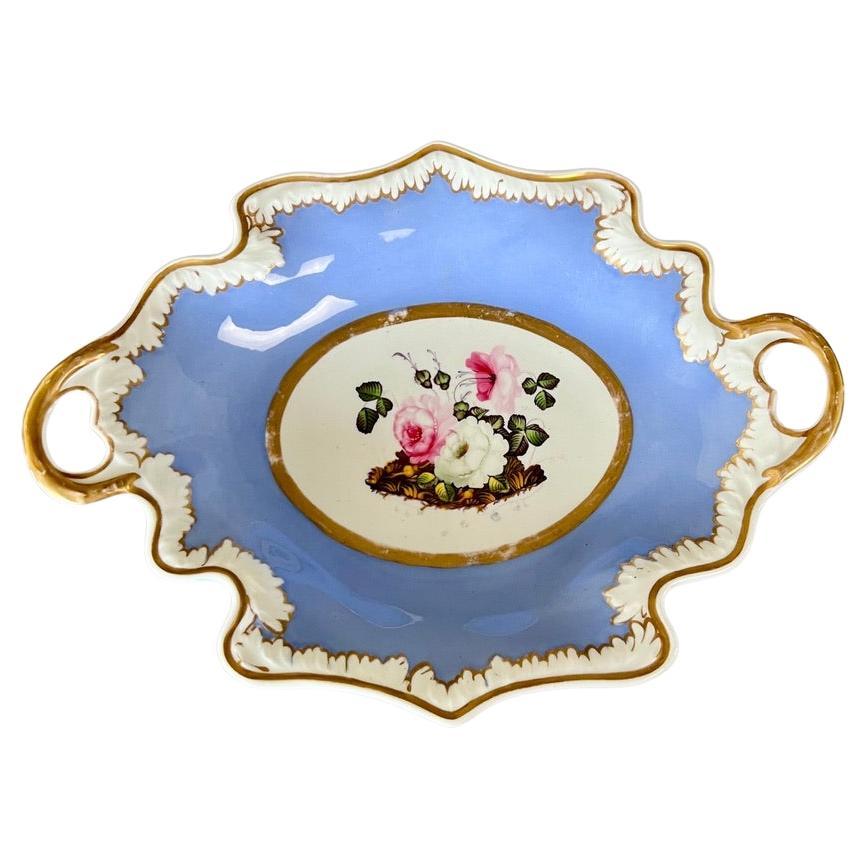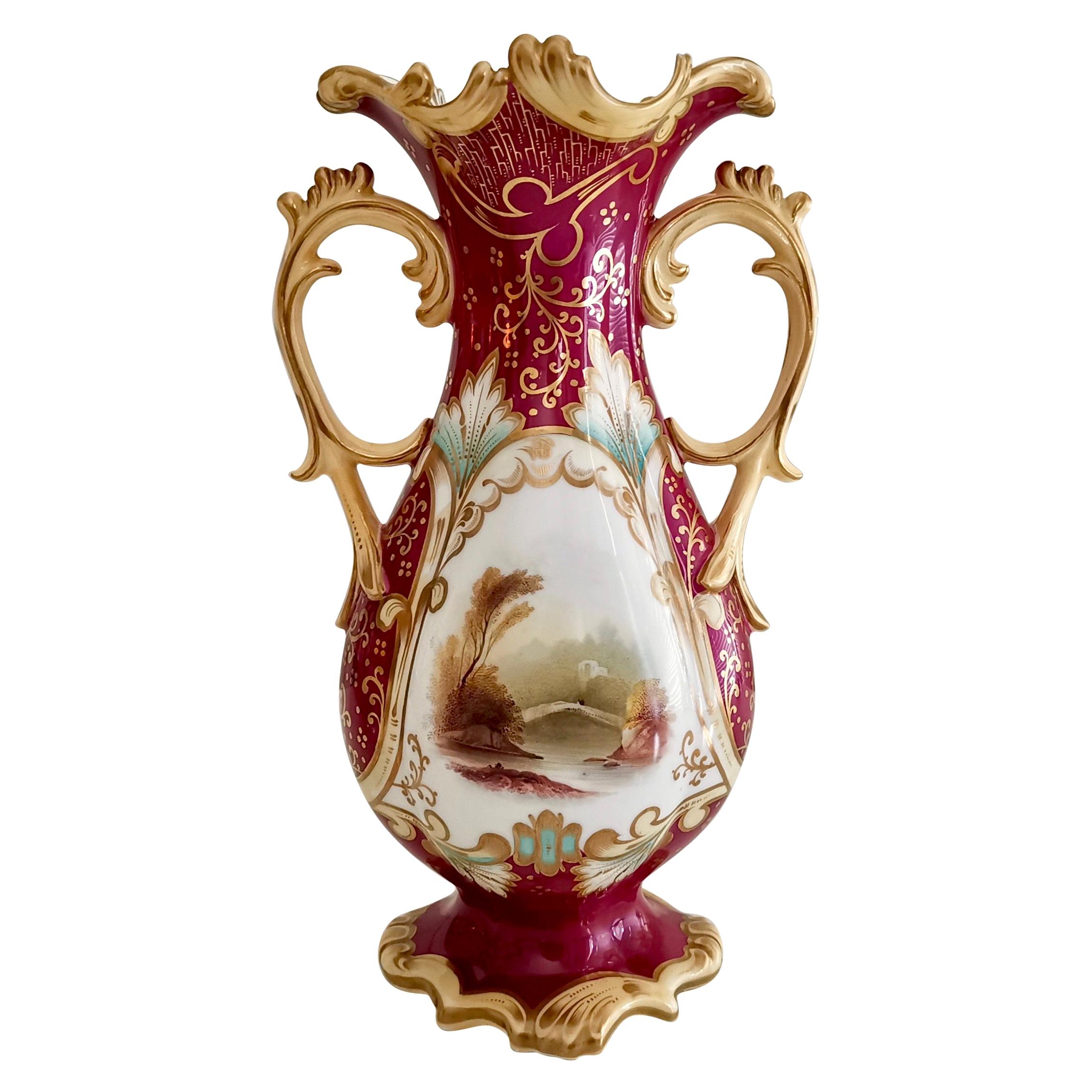Items Similar to Samuel Alcock Footed Porcelain Sauce Tureen, Maroon with Flower Sprays, ca 1842
Want more images or videos?
Request additional images or videos from the seller
1 of 17
Samuel Alcock Footed Porcelain Sauce Tureen, Maroon with Flower Sprays, ca 1842
About the Item
A footed two-handled sauce tureen with cover, maroon and pale yellow ground with beautiful hand painted flower sprays on lower part of body; twisted handles and a petticoat stem
Pattern 2/817
Year: ca 1842
Size: 20cm tall incl. finial (8.5”)
Condition: very faint stress cracks on inside, these don’t go through the body
The Samuel Alcock factory was operative in Staffordshire between 1822 and 1856, after which it was bought by Sir James Duke and Nephews. The factory started as a partnership between the young Samuel Alcock and the older Ralph Stevenson, who provided the factory and capital. Alcock quickly took the factory to great heights, building one of the biggest factories of its time. Alcock jumped on the new Rococo Revival fashion and served a huge new middle class market. The reason we now don't hear much about Samuel Alcock porcelain is that much of it has been mis-identified over the years and attributed to Coalport, Ridgway, Rockingham or others; Alcock did not mark any of his porcelain save a few rare pieces, and the numbering system is difficult to understand. However, the wares are still wide spread and many are of great quality.
This sauce tureen forms part of the Murray Pollinger Collection of Samuel Alcock Porcelain.
Murray Pollinger was a passionate collector of Samuel Alcock porcelain. He was known as a true gentleman, impeccably dressed, always kind and modest - even some of his porcelain collecting friends had no idea about the size and importance of his collection. From the mid 1980s until shortly before his death in 2022 he collected many thousands of pieces and painstakingly catalogued them. He also went on trips to Staffordshire to discover the history of Samuel Alcock from whatever little documentation has been preserved. Through his painstaking work, Pollinger was able to make sense of the pattern numbering system that was used, and this was a huge step forward in identifying and understanding the porcelain. A website with the results of his research will be made available over the course of 2023. While he sold off about half of his collection in 2016, the remaining half is now made available to a new generation of collectors.
Antique British porcelain is never perfect. Kilns were fired on coal in the 1800s, and this meant that china from that period can have some firing specks from flying particles. British makers were also known for their experimentation, and sometimes this resulted in technically imperfect results. Due to the shrinkage in the kiln, items can have small firing lines or develop crazing over time, which should not be seen as damage but as an imperfection of the maker's recipes, probably unknown at the time of making. Items have often been used for many years and can have normal signs of wear, and gilt can have signs of slight disintegration even if never handled. I will reflect any damage, repairs, obvious stress marks, crazing or heavy wear in the item description but some minor scratches, nicks, stains and gilt disintegration can be normal for vintage items and need to be taken into account.
There is widespread confusion on the internet about the difference between chips and nicks, or hairlines and cracks. I will reflect any damage as truthfully as I can, i.e. a nick is a tiny bit of damage smaller than 1mm and a chip is something you can easily see with the eye; a glazing line is a break in the glazing only; hairline is extremely tight and/or superficial and not picked up by the finger; and a crack is obvious both to the eye and the finger. Etcetera - I try to be as accurate as I can and please feel free to ask questions or request more detailed pictures!
- Creator:Samuel Alcock & Co. (Maker)
- Dimensions:Height: 1 in (2.54 cm)Width: 1 in (2.54 cm)Depth: 1 in (2.54 cm)
- Sold As:Set of 2
- Style:Rococo Revival (Of the Period)
- Materials and Techniques:
- Place of Origin:
- Period:
- Date of Manufacture:circa 1842
- Condition:Wear consistent with age and use. very faint stress cracks on inside, these don’t go through the body.
- Seller Location:London, GB
- Reference Number:
About the Seller
5.0
Platinum Seller
These expertly vetted sellers are 1stDibs' most experienced sellers and are rated highest by our customers.
Established in 2016
1stDibs seller since 2019
208 sales on 1stDibs
Typical response time: 1 hour
- ShippingRetrieving quote...Ships From: London, United Kingdom
- Return PolicyA return for this item may be initiated within 14 days of delivery.
More From This SellerView All
- Samuel Alcock Footed Comport, Melted Snow, Periwinkle Lilac, Flowers, ca 1822By Samuel Alcock & Co.Located in London, GBA footed rectangular central comport or centre piece, periwinkle / lilac ground with melted snow and holly leaf borders and flowers, a large pink wild rose painting in the centre Th...Category
Antique 1820s English Regency Serving Bowls
MaterialsPorcelain
- Samuel Alcock Porcelain Leaf Dish, Periwinkle Blue with Yellow Flower, ca 1822By Samuel Alcock & Co.Located in London, GBA one-handled leaf dish with white melted snow and holly leaf border on a periwinkle ground, and a beautiful flower study of a yellow ranunculus in the centre There are several other items available in near-identical style, see separate listings. Pattern 507 Year: ca 1822 Size: 26cm X 21.5cm (10.25” X 8.5”) Condition: some rubbing The Samuel Alcock factory was operative in Staffordshire between 1822 and 1856, after which it was bought by Sir James Duke and Nephews. The factory started as a partnership between the young Samuel Alcock and the older Ralph Stevenson, who provided the factory and capital. Alcock quickly took the factory to great heights, building one of the biggest factories of its time. Alcock jumped on the new Rococo Revival fashion and served a huge new middle class market. The reason we now don't hear much about Samuel Alcock porcelain...Category
Antique 1820s English Regency Serving Bowls
MaterialsPorcelain
- Samuel Alcock Porcelain Basket, Rococo Revival, Maroon, Flower Reserves, ca 1835By Samuel Alcock & Co.Located in London, GBA maroon ground basket in Rococo Revival style with pierced pale yellow ends, a twig handle and five flower reserves with single flowers. Pattern 2/5610 Year: ca 1835 Size: 22.5cm (8.75”) long, 13cm (5”) tall Condition: handle has been repaired, see last picture; some rubbing This basket forms part of the Murray Pollinger Collection of Samuel Alcock Porcelain...Category
Antique 1830s English Rococo Revival Decorative Baskets
MaterialsPorcelain
- Samuel Alcock Porcelain Muffin Dish, White, Flowers by William Pollard, ca 1826By Samuel Alcock & Co., William PollardLocated in London, GBA muffin dish with cover, simple white ground with fruit basket finial surrounded by moulded acanthus leaves, with fine flower sprays and wild strawberries by William Pollard Proven...Category
Antique 1820s English Regency Serving Bowls
MaterialsPorcelain
- Samuel Alcock 2-Handled Dish, Periwinkle Blue, Lilac, with Flowers, ca 1823By Samuel Alcock & Co.Located in London, GBA two-handled leaf shaped dish with white melted snow border on a periwinkle ground, and a beautifully painted bouquet of pink and white roses in the centre There are several other ...Category
Antique 1820s English Regency Serving Bowls
MaterialsPorcelain
- Samuel Alcock Porcelain Vase, Maroon with Landscapes, Rococo Revival, ca 1840By Samuel Alcock & Co.Located in London, GBOn offer is a beautiful porcelain vase made by Samuel Alcock circa 1840 during the Rococo Revival era. It has a maroon ground and a stunning landscape painting. Samuel Alcock was on...Category
Antique 1840s English Rococo Revival Vases
MaterialsPorcelain
You May Also Like
- Antique Meissen Porcelain Bowl with Hand-Painted Flowers and Gold DecorationLocated in Copenhagen, DKAntique Meissen porcelain bowl with hand-painted flowers and gold decoration. Early 20th century. Measures: 28.5 x 5 cm. In excellent condition. 1st factory quality. Stamped.Category
Early 20th Century German Rococo Revival Porcelain
MaterialsPorcelain
- A fine English porcelain Punch Bowl attributed to Samuel Alcock c.1830By Samuel Alcock & Co.Located in Exeter, GBA fine English porcelain Punch Bowl attributed to Samuel Alcock c.1830. Superbly painted summer flowers to the centre interior of the bowl...Category
Antique 19th Century Porcelain
MaterialsPorcelain
- Meissen Porcelain Bowl with Flowers and Foliage in ReliefLocated in Copenhagen, DKMeissen Porcelain bowl with flowers and foliage in relief and gold decoration, 20th century. Two pieces in stock. Measures: 22.5 x 9.5 cm. In very ...Category
20th Century German Porcelain
MaterialsPorcelain
- Six Royal Copenhagen Golden Basket Porcelain Bowls with FlowersLocated in Copenhagen, DKSix Royal Copenhagen Golden Basket porcelain bowls with flowers and gold decoration. 1960s. Largest bowl measures: 14.5 x 3 cm. Bottle...Category
Vintage 1960s Danish Porcelain
MaterialsPorcelain
- Five Small Herend Porcelain Bowls with Hand-Painted Purple FlowersLocated in Copenhagen, DKFive small Herend porcelain bowls with hand-painted purple flowers and gold decoration. Mid-20th century. Largest measures: 12 x 2 cm. In excellent condition. Stamped.Category
Mid-20th Century Hungarian Porcelain
MaterialsPorcelain
- Davenport, England, Bowl in Cream-Colored Porcelain with Flowers and FoliageLocated in Copenhagen, DKDavenport, England. Bowl in cream-colored porcelain with flowers and foliage in relief. Early 20th century. Measures: 12.5 x 7 cm. In excellent condition. Stamped.Category
Early 20th Century English Porcelain
MaterialsPorcelain

